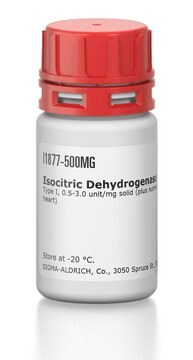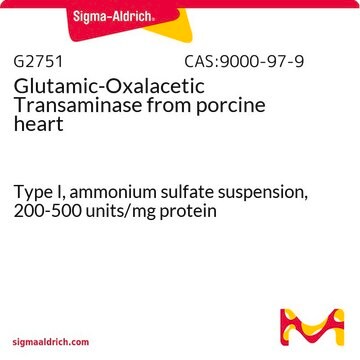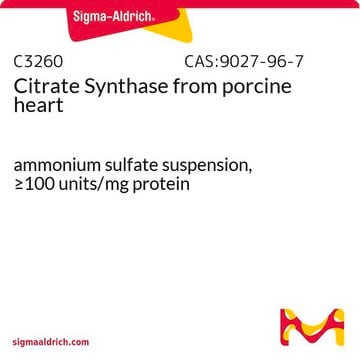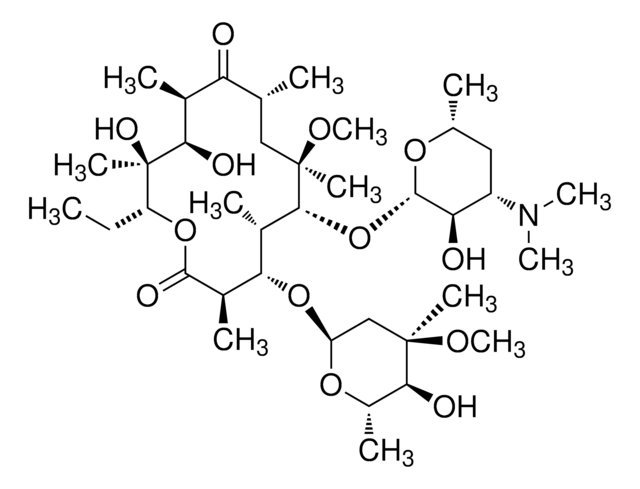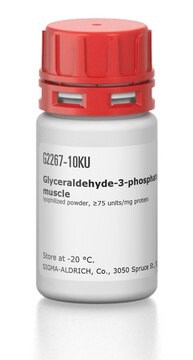A5384
Aconitase from porcine heart
Synonym(s):
Aconitate hydratase, Citrate (isocitrate) hydrolyase
Sign Into View Organizational & Contract Pricing
All Photos(1)
About This Item
CAS Number:
MDL number:
UNSPSC Code:
12352204
NACRES:
NA.54
Recommended Products
biological source
Porcine heart
Quality Level
form
solid
mol wt
~66 kDa by gel filtration
storage temp.
−20°C
Application
Aconitase may be usefull in diabetes research as well as to study structural conservation between iron-responsive element binding proteins (IRE-BP) and isomerases .
Biochem/physiol Actions
Aconitase catalyses the stereo-specific isomerization of citrate to isocitrate via cis-aconitate in the tricarboxylic acid cycle. Aconitase is inhibited by cyanide, sulfide and copper and mercury at low concentrations. It is competitively inhibited by trans-aconitate. Aconitase contains an internal Fe-S cluster which is responsible for its activity.
Unit Definition
One unit will convert 1.0 μmole of citrate (via cis-aconitate) to isocitrate per min at pH 7.4 at 25 °C.
Analysis Note
Crude preparation containing aconitase activity
Storage Class Code
11 - Combustible Solids
WGK
WGK 3
Flash Point(F)
Not applicable
Flash Point(C)
Not applicable
Personal Protective Equipment
dust mask type N95 (US), Eyeshields, Gloves
Certificates of Analysis (COA)
Search for Certificates of Analysis (COA) by entering the products Lot/Batch Number. Lot and Batch Numbers can be found on a product’s label following the words ‘Lot’ or ‘Batch’.
Already Own This Product?
Find documentation for the products that you have recently purchased in the Document Library.
Customers Also Viewed
Bassel Dawod et al.
Scientific reports, 10(1), 13343-13343 (2020-08-10)
Triple-negative breast cancer (TNBC) is an invasive subtype of breast cancer but paradoxically associated with increased tumor-infiltrating leukocytes. The molecular and cellular mechanisms underlying TNBC immunobiology are incompletely understood. Interleukin (IL)-17A is a pro-inflammatory cytokine that has both pro- and
Megan J Morgan et al.
Plant physiology, 161(1), 397-407 (2012-11-21)
Organic acid content is regarded as one of the most important quality traits of fresh tomato (Solanum lycopersicum). However, the complexity of carboxylic acid metabolism and storage means that it is difficult to predict the best way to engineer altered
Ewelina Michta et al.
Environmental microbiology, 14(12), 3203-3219 (2012-11-03)
In many organisms, aconitases have dual functions; they serve as enzymes in the tricarboxylic acid cycle and as regulators of iron metabolism. In this study we defined the role of the aconitase AcnA in Streptomyces viridochromogenes Tü494, the producer of
Lucy M Hinder et al.
The Journal of endocrinology, 216(1), 1-11 (2012-10-23)
Diabetic neuropathy (DN) is the most common complication of diabetes and is characterized by distal-to-proximal loss of peripheral nerve axons. The idea of tissue-specific pathological alterations in energy metabolism in diabetic complications-prone tissues is emerging. Altered nerve metabolism in type
Béatrice Py et al.
Molecular microbiology, 86(1), 155-171 (2012-09-13)
Biosynthesis of iron-sulphur (Fe-S) proteins is catalysed by multi-protein systems, ISC and SUF. However, 'non-ISC, non-SUF' Fe-S biosynthesis factors have been described, both in prokaryotes and eukaryotes. Here we report in vitro and in vivo investigations of such a 'non-ISC
Our team of scientists has experience in all areas of research including Life Science, Material Science, Chemical Synthesis, Chromatography, Analytical and many others.
Contact Technical Service